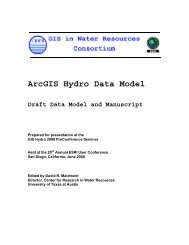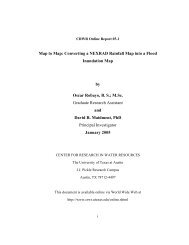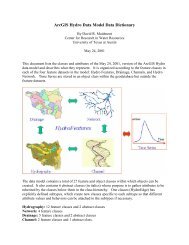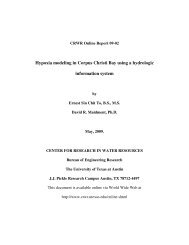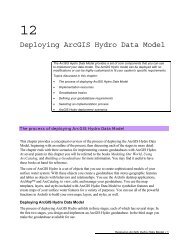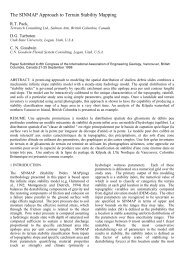View the Whole Report - Center for Research in Water Resources ...
View the Whole Report - Center for Research in Water Resources ...
View the Whole Report - Center for Research in Water Resources ...
You also want an ePaper? Increase the reach of your titles
YUMPU automatically turns print PDFs into web optimized ePapers that Google loves.
5. LABORATORY TESTS OF SILT FENCES AND A ROCK BERM<br />
5.1 Flume Tests<br />
The sediment removal per<strong>for</strong>mance <strong>for</strong> <strong>the</strong> two most common temporary controls<br />
<strong>in</strong> <strong>the</strong> <strong>in</strong>ventory, silt fences and rock berms, was <strong>in</strong>vestigated under control conditions <strong>in</strong><br />
an outdoor flume. Monitor<strong>in</strong>g controls <strong>in</strong> a flume allowed control over such variables as<br />
<strong>the</strong> <strong>in</strong>fluent flow rate and TSS concentrations. Data were collected us<strong>in</strong>g simulated<br />
runoff events <strong>in</strong> <strong>the</strong> flume. The hydraulic characteristics of <strong>the</strong>se controls also were<br />
evaluated.<br />
5.1.1 Flume and Bulk <strong>Water</strong> Delivery System<br />
An outdoor flume at <strong>the</strong> <strong>Center</strong> <strong>for</strong> <strong>Research</strong> <strong>in</strong> <strong>Water</strong> <strong>Resources</strong> (CRWR) was<br />
used as <strong>the</strong> test bed <strong>for</strong> <strong>the</strong> sediment control experiments. The steel flume was 61-m-long<br />
with a cross-section that is 0.76-m wide and 0.6-m deep. The slope of <strong>the</strong> flume is<br />
approximately 0.33 %. A 10-cm sand and gravel bed was used to simulate field soil<br />
conditions. The th<strong>in</strong> layer of highly permeable soil allowed some <strong>in</strong>filtration, which<br />
might be expected <strong>in</strong> <strong>the</strong> field. The flume and water delivery system used <strong>for</strong> <strong>the</strong><br />
sediment control tests are shown <strong>in</strong> Figure 5.1.<br />
Bulk water was circulated through <strong>the</strong> elevated water tank near <strong>the</strong> head of <strong>the</strong><br />
flume. The water level <strong>in</strong> this tank was sufficient to drive <strong>the</strong> simulated runoff through<br />
<strong>the</strong> mix<strong>in</strong>g tank, flume, and sediment controls. <strong>Water</strong> <strong>for</strong> each test was dra<strong>in</strong>ed from <strong>the</strong><br />
elevated tank, over a V-notch weir and <strong>in</strong>to <strong>the</strong> rapid mix<strong>in</strong>g tank at <strong>the</strong> head of <strong>the</strong><br />
flume. A constant head <strong>in</strong> <strong>the</strong> elevated water tank was ma<strong>in</strong>ta<strong>in</strong>ed to provide a constant<br />
flow rate to <strong>the</strong> mix<strong>in</strong>g tank.<br />
The V-notch weir allowed <strong>the</strong> measurement of <strong>the</strong> bulk water <strong>in</strong>fluent flow rate<br />
<strong>in</strong>to <strong>the</strong> flume. The weir was calibrated by fill<strong>in</strong>g a sealed section of <strong>the</strong> flume at<br />
different flow rates and monitor<strong>in</strong>g <strong>the</strong> rate of change of <strong>the</strong> water level. The product of<br />
<strong>the</strong> constant surface area of <strong>the</strong> test section of <strong>the</strong> flume and <strong>the</strong> rate of change of <strong>the</strong> level<br />
35




